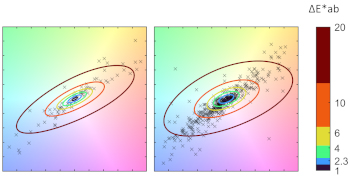
The Monk Skin Tone (MST) scale, comprising ten digitally defined colors, represents a diverse range of skin tones and is utilised by Google to promote social equity. The MST scale also has the potential to address health disparities in the medical field. However, these colors must be printed as physical charts for health practitioners and researchers to conduct visual comparisons. This study examines the colorimetric characteristics of the MST scale and establishes two per-patch acceptance criteria to determine the acceptability of a printed MST chart using a four-tier grading method. A software tool was developed to assist end users in printing accurate MST charts. The tool was tested with four printer/paper combinations, including inkjet, dye sublimation, and laser printers. Results show that a wide color gamut covering the brightest and darkest MST levels is crucial for producing an accurate MST chart, which can be achieved with a consumer-grade inkjet printer and glossy paper.

The Monk Skin Tone (MST) scale, comprising ten digitally defined colors, represents a diverse range of skin tones and is utilised by Google to promote social equity. The MST scale also has the potential to address health disparities in the medical field. However, these colors must be printed as physical charts for health practitioners and researchers to conduct visual comparisons. This study examines the colorimetric characteristics of the MST scale and establishes two per-patch acceptance criteria to determine the acceptability of a printed MST chart using a four-tier grading method. A software tool was developed to assist end users in printing accurate MST charts. The tool was tested with four printer/paper combinations, including inkjet, dye sublimation, and laser printers. Results show that a wide color gamut covering the brightest and darkest MST levels is crucial for producing an accurate MST chart, which can be achieved with a consumer-grade inkjet printer and glossy paper.

For mass production, multiple color halftoning screen printing (MCHSP) can be considered as the alternative textile printing technology when vivid color gradation is needed and cost for digital printing is concerned. Essentially, MCHSP utilizes the same equipment as traditional screen printing to print overlapped multiple color gradation under halftoning patterns by applying the dedicated treatments on color separation and calibration. In order to ensure the color quality, the equipment calibration and tone curve compensation are required to compensate the variables from equipment setup and heterogeneous fabrics. In this research, we provided the procedure of tone curve compensation to alleviate the discrepancy from heterogeneous fabrics. The experimental result based on 55 samples of 44 different fabrics shows the compensation effectiveness and reveal the distribution of average compensation percentage across fabrics.

In this paper we propose 4DBODY system which realizes full body 4D scanning of human in motion. It consists eight measurement heads based on single frame structured light method. All heads works synchronously with frequency 120 Hz with spectral separation to eliminate crosstalk. Single frame method is based on projection of sinusoidal fringe pattern with special marker allowing for absolute phase reconstruction. We develop custom made unwrapping procedure adjusted for human body analysis. We could achieve 0.5 mm spatial resolution and 0.3 mm of accuracy within a 1.5 x 1.5 x 2.0 m3 working volume. We integrated treadmill into system which allows to perform walking experiments. We present some results of measurements with initial validation of 4DBODY system.